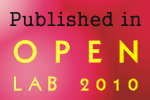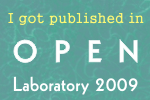It has not escaped Twitter’s notice that the Watson & Crick paper is 60 years old today . Sorry, too busy to be really creative, so here is a repost from 2009. Think of it as a transposon. Short quiz and a movie for DNA day. 1) We celebrate DNA day because: a) Congress said so […]
You have until Friday Saturday, April 20th to submit your abstracts to the Automated Function Prediction meeting, an ISMB 2013 Special Interest Group and CAFA: Critical Assessment of Function Annotations. Keynote speakers: Patricia Babbitt, University of California, San Francisco. Protein similarity networks: Identification of functional trends from the context of sequence similarity Alex Bateman, European Bioinformatics […]
I am not inclined to write polemic posts. I generally like to leave that to others, while I take the admittedly easier route of waxing positive over various bits of cool science I find or hear about, and yes, occasionally do myself. But WSJ editorial from E.O. Wilson has irked me so much, I have […]
A new journal, Molecular Metabolism has the following policies: one week for reviews, and three possible outcomes only: Reject, Accept, or Minor Revision. Good for them on both decisions. Bonus: your editors are Mr. Blonde, Mr. Blue, Mr. Brown, Mr. Orange and Mr. Pink. And they are professionals (although they may not tip).
The Automated Function Prediction, an ISMB 2013 Special Interest Group meeting and CAFA: Critical Assessment of Function Annotations. July 20, 2013, Berlin Keynote speakers Patricia Babbitt, University of California, San Francisco Alex Bateman, European Bioinformatics Institute Anna Tramontano, “La Sapienza” University, Rome. Key dates: April 20, 2013: Deadline for submitting extended abstracts posters & talks May […]
From the organizers of CAGI 2013. I have been to the Critical Assessment in 2010 and 2011, and even participated as an assessor. It’s a fun meeting, and if your work involves prediction of phenotypes from genotypes, there is still time (just about) to accept some of the challenges. The Critical Assessment of Genome Interpretation […]
“Well, in our country,” said Alice, still panting a little, “you’d generally get to somewhere else — if you run very fast for a long time, as we’ve been doing.” “A slow sort of country!” said the Queen. “Now, here, you see, it takes all the running you can do, to keep in the same […]
This is romantic! So listen up! A 3D heart shape may be drawn using the following implicit function: Or, in Python: def heart_3d(x,y,z): return (x**2+(9/4)*y**2+z**2-1)**3-x**2*z**3-(9/80)*y**2*z**3 Trouble is, there is no direct way of graphing implicit functions in Python. But anything can be found on Stack Overflow. Putting it all together: #!/usr/bin/env python from mpl_toolkits.mplot3d import […]
Richard Feynman passed on Twenty five years ago today. His legacy lies not only in physics, but (to more people perhaps), in his ability to communicate science, and the love of science. One of my favorite Feynman moments is in this video. I show it to students in a course section I teach about the […]
Found on 9gag.com. EDIT: as pointed out by Jason McDermott, hypothesis should probably be used here instead of theory.
Back to ancient life, what exactly defines life, and where does life end and non-life begin. One of my favorite subjects, and one of which I am the least knowledgeable. Doesn’t stop me writing about it though. Viruses are… well… not really life. Or so says common wisdom. They have some elements of life: a […]
There has been a lot of discussion recently on this blog and others on the need for robust scientific software. Most of the discussion I have been involved in comes from bioinformaticians, because, well, I am one. There has been plenty of talk about code robustness, sharing, and replicability vs. reproduciblity. I do not want […]
So there was a lot written over the blogosphere, twittersphere and what-have-you-sphere about the to publish code in scientific research. The latest volley was fired from a post at biostars.org from “JermDemo” which also mentioned my post on making accountable research software by forming a volunteer “Bioinformatics Testing Consortium”. (My post, not my idea). I won’t […]





